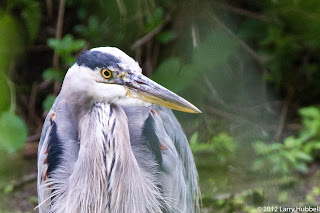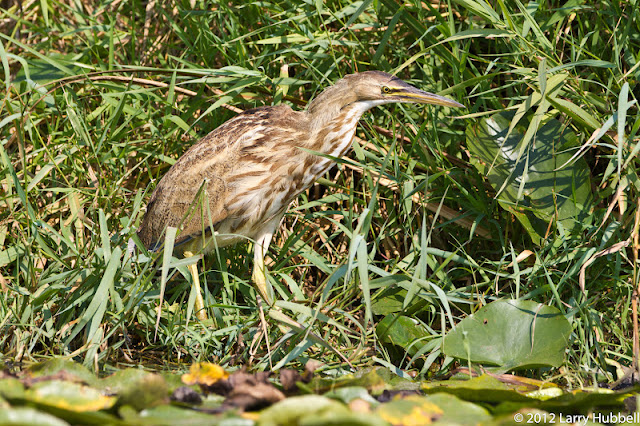Peregrine Falcons are not just the fastest birds they are the fastest living creatures on earth. Their top, recorded speeds, when diving, are way over 200 miles per hour. Take a moment and check out this video.
This photo shows the star of our story.
Plus the photo contains at least two clues about the story. Take a look and see if you can spot them. Note: The red brick in the foreground is not one of the clues.
Our story begins in the middle but it will all make sense in the end. In mid-September 2011, almost exactly one year ago. Carkeek Park seemed like a great place to do some watercolor painting. At the southern end of the beach in the shade of a small tree I found a nice place to work while looking out over Puget Sound.
I sat my camera on a log in front of me and proceeded to paint. The air was clean and cool, the water slapped against the beach and once when a bird of prey passed overhead all the gulls leapt off the beach and settled just off shore. The beach around me appeared to be completely empty of any living creature. My head was down focusing on my painting when suddenly I heard a very loud THUMP directly in front of me. Startled I looked up to see this scene.
I grabbed my camera and started shooting. The Peregrine Falcon had just landed on the beach but her landing was not the source of the noise. Your first hint from the photo was the "rock" just behind the Falcon. It is actually the body of a Rock Dove, more commonly known as a Pigeon. Our Falcon must have knocked the Rock Dove out of the air with an incredible amount of force to create such a loud sound.
Normally a peregrine hits its prey at high speed with a closed foot, which kills it and then turns in the air and grabs the body. It turns out this Falcon was a rather young bird, just learning to hunt, maybe it missed the grab part.
Initially the Falcon began to pull the feathers off her lunch, but sadly she heard the clicking of my camera as I snapped these photos.
She decided the beach was too crowded and proceeded to take her lunch elsewhere.
The effort required to lift the pigeon is clearly evident in this photo.
The second hint from the photo above was the band around the lower leg of the Falcon. As the Falcon takes to the air bands on both legs are visible.
With the software I had last year I could not actually read anything on the bands. At some point I got better software and then happened to look more closely at the photo.
While the enlarged photo is very blurry it turned out to be good enough. Last week I finally remembered to send a copy of the photo to Bud Anderson. Bud is a highly respected expert on falcons and his organization and website called the Falcon Research Group displays an incredible amount of knowledge and hard work.
Bud forwarded my photo to Chris Kanit and Ed Deal. The bird was identified as 69Z a chick that was banded in May of 2011. Here is a photo Ed took during the banding process.
Here is Ed's email about the banding experience:
Larry,
Thanks for sharing the photo of that PEFA.........as Kanit points out, there were two birds banded in the Seattle area that had a Z in the band.....62-Z and 69-Z. When I magnify your photo it sure looks like 69 and not 62......Mike MacDonald and I banded 69-Z as a three week old chick on 20 MAY 2011 at the I-5 Ship Canal Bridge nest. She spent two weeks in rehab at Sarvey Wildlife Center and was released back at the nest site on 25 JUNE 2011. Its nice to know she was still "out there" as of mid-SEPT 2011. And great shot by the way.......thats a odd way to carry a pigeon!
I've attached a photo of the four chicks, the Mom and Mike from 20 MAY 2011. He's reaching for a pigeon band he saw in the nest box....I just missed getting a picture of Mom sinking her talons into Mike's forearm as he reached.
Best,
Ed Deal
PS. 69-Z is a grand-daughter of Stewart and Belle, the WAMU pair.
More photos of this banding operation can be seen on Flicker. I personally find it to be a very courageous and amazing process. By the way if you stop, with a pair of binoculars, in the wide spot on the southwest walkway on the University Bridge you can see the top of the nesting box. Of the four concrete support piers (for I-5) near the waters edge, the nest box is above the one to the northeast. Ed expects the nest will be used again this spring. It will be exciting to watch even from a distance.
Back at the beach I felt incredibly lucky to watch this magnificent bird, with lunch "in hand", turn slowly to the south and fly away. At the last moment, with the peregrine already in retreat, one of the gulls suddenly got a bit brave. Squawking loudly it half-heartedly chased after the Falcon for a few wing beats.
Today I realize that I was even more lucky to see a banded bird. Ed says that Bud, Mike, himself and other volunteers have banded over 400 chicks in Washington state. We in Washington are very lucky to have such brave and industrious folks working in our state.
That single little band of metal links 69Z to her birth place under the ship canal bridge. Which in turn tells us she was only 4 and half months old at the time of my photos. From this we know that she had just learned to hunt. Which explains why she hadn't yet figured out the most aerodynamic way to carry her prey. It also links her to her father that was born on top of the Washington Mutual tower and to her grandparents (Stewart and Belle) that lived and raised young in downtown Seattle for many years.
Today's blog is intended as a heartfelt "Thank You!" to Bud, Ed, Mike, Chris and all the other volunteers that go to great lengths and heights to learn about the fastest birds on earth.
Larry
PS: If you take photos of peregrines please watch out for 69Z and her relatives. The first winter for a falcon is the most challenging, but we now know that 69Z had at least learned to hunt before she faced her first winter. Her aunts and uncles have been spotted in California, Oregon and the San Juan Islands. So 69Z could be hundreds of miles away or right outside your window!
Odds and Ends:
By the way another way to learn more about falcons is the excellent book, "Falcons of North America" by Kate Davis. Bud recommended the book and it is incredible. It is easy to read and yet it is wonderfully full of details plus great photos.
A very interesting link about peregrine falcons in Portland, Oregon was included in comment number three below. The link is:
I hope you enjoy it.

























































